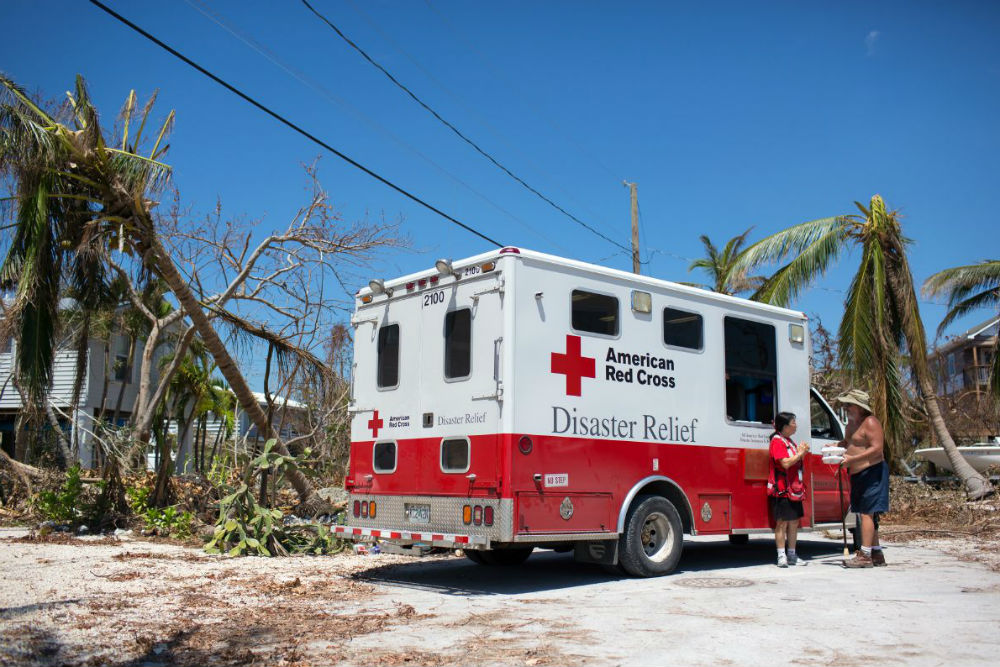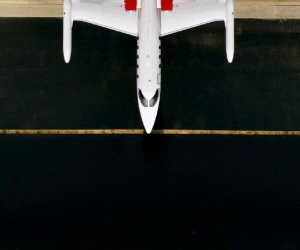Caribbean Hurricane and Mexican Earthquake Relief: How Travelers Can Help
 The Red Cross delivers hot meals in Cudjoe Key, Florida, after Hurricane Irma. Photo: Marko Kokic for The American Red Cross
The Red Cross delivers hot meals in Cudjoe Key, Florida, after Hurricane Irma. Photo: Marko Kokic for The American Red Cross This month has been one natural disaster after another. First Texas was hit by Hurricane Harvey, and then Hurricane Irma arrived— a Category Five storm that tore across the Atlantic with 185mph winds and wreaked havoc on Caribbean and U.S. islands, including Barbuda, the British Virgin Islands, Anguilla, Turks and Caicos, the U.S. Virgin Islands, Cuba, the Florida Keys, Haiti, and more. The death toll was at least 37 in the Caribbean (plus 12 in the U.S.), and the storm left millions of people without homes, power, and basic necessities. Right on its heels, Hurricane Maria struck Puerto Rico, the strongest storm to hit the island in 80 years, leaving 100% of the residents without power and with months of clean-up. Almost simultaneously, a trio of earthquakes rocked Mexico, causing untold damage and killing at least 300.
International relief organizations are working tirelessly in the immediate aftermath, but it’s clear that the recovery efforts are going to be long ones in the Caribbean, Mexico, and in the U.S.
As travelers and global citizens, we gratefully enjoy these destinations in the good times—which is why we now feel compelled to do our part in the rough times. Readers have written in asking how they can help, and we’ve compiled a list of organizations in need of donations below. You can also check the website and Facebook page of your own favorite Caribbean and Mexican hotels and attractions. Many are launching individual funds to provide for their employees.
One such fund on our list was set up by Bruce Jakubovitz, a loyal WOW List traveler and owner of the now destroyed Summit Hotel on St. Maarten. Bruce’s parents bought the hotel in 1973. “I spent 44 years growing up there,” he told us on the phone, “from the time I was a teenager to my college years, to my wife coming down there when we were first dating, and my kids visiting since they were infants. I refer to the head of housekeeping as my second mom because she’s known me for so long.” Sadly, like many other hotels on St. Maarten, the Summit was completely destroyed by Irma. Entire floors of buildings were blown off, the pool deck was gusted away, and other structures were completely flattened. Thankfully no one was hurt, but as Bruce points out, it’s the staff that’s suffering now. “Some lost their homes entirely, some lost vehicles or property, some had family whose homes were destroyed,” he said. “There’s no one on St. Maarten who wasn’t touched by this. It’s just staggering.” And this is just one example of the devastation that hit so many islands during the storm. There are so many more.
According to the Center for International Disaster Information (part of the U.S. Agency for International Development Office of U.S. Foreign Disaster Assistance), monetary donations are the best way to help those impacted by natural disasters. So instead of trying to collect clothes or supplies to ship overseas, consider a financial donation if you truly want to help. The reason: Money enables relief organizations to buy exactly what they need, when they need it, and to purchase those supplies in the most convenient, nearby locations. Conversely, material donations end up creating additional costs and logistical complications for relief organizations, including shipping fees, additional customs fees and taxes, and the necessity that a person be on-site in the affected area to receive and then distribute the items. For more explanation, see the CIDI website. And to learn more about any organization you are considering supporting, you can research their ratings (usually based on factors such as financial and programmatic backgrounds) at GiveWell, Charity Navigator, Charity Watch, and the Better Business Bureau.
All Locations
Center for Disaster Philanthropy
Whereas many relief organizations focus on the immediate challenge of rescuing survivors and supplying food, water, and shelter to those affected (and rightly so), it’s clear that the destruction caused by Hurricane Irma is going to require long-term recovery assistance. That’s the CDP’s focus. A nonprofit formed after the 2004 tsunami and Hurricane Katrina, the CDP is not an on-the-ground relief provider, but rather a group dedicated to helping donors make more informed and more effective choices. In its FAQ, CDP explains: “In response to the needs that will arise following this devastating storm, the CDP Hurricane Harvey Recovery Fund will focus on medium and long-term rebuilding needs. We expect the long-term needs to be rebuilding homes, businesses, infrastructure, meeting the needs of young children, supporting mental health needs, and boosting damaged agricultural sectors. CDP will distribute the funds 2-9 months from now to appropriate nonprofit organizations working on mid-term and long-term recovery efforts.” Read more and donate here.
Center for International Disaster Information
Although CIDI is not a relief organization itself, it is very useful as a central bank of information about relief efforts and organizations. Its website lists organizations involved in relief projects for all of this season’s natural distasters, with links to their sites, including the following:
- Heart to Heart International
- International Medical Corps
- American Red Cross
- Catholic Relief Services
- UNICEF
- Save the Children (see also Facebook’s matching campaign, below)
Direct Relief
Direct Relief is a nongovernmental, nonsectarian, and not-for-profit humanitarian aid organization that offers assistance programs in the areas of health, disease prevention and emergency preparedness and response. They are active in every U.S. state and more than 80 countries—including Mexico City when the earthquake hit. Their website provides regular reports on damage status in this season’s affected areas, as well as a donation page where you can select the fund you’d like to support. Read more here.
Global Giving
Global Giving is a fund-raising site that pools donations and distributes them among locally driven relief organizations that it vets for transparency, accountability, and adherence to relevant government regulations. Any organization that passes muster and is admitted into the Global Giving community then has to continue to submit regular reports to stay in it. More than 165 organizations are currently on that list, including ones working on relief for victims of Hurricane Harvey, Hurricane Irma, Hurricane Maria, the Mexico earthquake, and more. Read more and donate here.
Individual GoFundMe and KindFund Campaigns
Some individual families, organizations, hotels, and community groups have set up direct personal campaigns on the crowdsourcing donation sites GoFundMe and KindFund. The monetary goals are often pretty small, but the stories are no less moving than the ones that have made big news. For example, in the Caribbean, we’ve seen pleas to help evacuate family members, to repair a Chabad community center, and to assist employees of the aforementioned Summit Hotel, the decimated resort owned by a traveler in our WendyPerrin.com community. While GoFundMe is the better known site of this kind and has more campaigns (including convenient individual pages that round up campaigns for Hurricane Harvey, Hurricane Irma, Hurricane Maria, and the Mexico earthquakes), KindFund takes half the fees that GoFundMe does—which means more of your donation goes to the people who really need it.
Samaritan’s Purse
This Christian evangelical relief organization has been providing assistance in disaster areas since 1970. They are currently helping in Texas, Florida, and the Caribbean. “They were one of the first into St. Maarten and they’ve done a terrific job,” Bruce told us. “So if you don’t have a specific resort or people to give to, by all means these general purpose organizations are great.” Read more and donate here.
Caribbean and Puerto Rico

The Summit Resort Hotel in St. Maarten is just one hotel destroyed by Hurricane Irma.
Antigua and Barbuda Red Cross
Barbuda was one of the first tragedies of Hurricane Irma. The tiny island (one half of the dual-island nation of Antigua and Barbuda) is largely underwater, 95% of its structures are destroyed, and most of its residents have finally managed to flee. The damage is estimated at more than $100 million. Read more and donate here.
Bahamas Red Cross
The Atlantis resort on Paradise Island in the Bahamas was unscathed by the hurricane, but it has rallied to the side of its neighbors by offering to match every dollar donated—one for one—to the Bahamas Red Cross and to Red Cross efforts in Florida. The campaign runs through October 31. Read more and donate here.
Caribbean Disaster Emergency Management Agency
This inter-governmental organization coordinates relief efforts across its 18 participating states (Anguilla, Antigua and Barbuda, Commonwealth of the Bahamas, Barbados, Belize, Commonwealth of Dominica, Grenada, Republic of Guyana, Haiti, Jamaica, Montserrat, St. Kitts & Nevis, Saint Lucia, St. Vincent & the Grenadines, Suriname, Republic of Trinidad & Tobago, Turks & Caicos Islands and the Virgin Islands.) So far, CDEMA is doing a great job of collecting updates from member states and compiling the info into a Situation Report PDF that details assistance efforts, damage statuses, and a list of needed items. Donate here.
Caribbean Tourism Organization
The CTO has 27 members, some of which were affected by the hurricane. The money collected by the CTO Relief Fund is funneled to the ministry of tourism for each affected country. Read more about the CTO here and donate here.
Caribbean Tourism Recovery Fund
The Caribbean Hotel and Tourism Association and Tourism Cares are two arms of the region’s tourism industry; they have joined forces via this fund that will focus on helping the islands rebound their tourism industry. According to the fund statement on the CHTA website, the money raised will be used for training and education initiatives for displaced and affected travel professionals; the restoration of attractions and cultural tourism nonprofits, like historical monuments, public spaces, or destroyed visitor centers; and more. The goal is to have the islands ready for visitors again by spring and summer 2018. Read more and donate here.
Facebook’s matching campaign
To support those affected by Hurricane Irma and Maria, Facebook will match donations to Save the Children up to $1 million. You can read more about the campaign on Facebook here, and donate through your own feed (informational posts are showing up in everyone’s feeds) or through Save the Children’s Facebook page.
NYC and FDNY Donation Drive for Puerto Rico
New York City has close ties to Puerto Rico, so it’s not surprising that the citizens across the city have jumped to action. In addition to notable Puerto Rican residents (Jennifer Lopez, Yankee Alex Rodriguez, ) donating large sums of money to relief efforts, the city Fire Department and Mayor Bill DeBlasio are running a collection drive for five specific, critically needed items (and those items only), which will be delivered to the ravaged island. There are collection points at 18 fire houses and EMS stations in all five boroughs. The five items are: diapers, baby food, batteries, first-aid supplies, and feminine hygiene products. Read more here.
Note: Per the website, all donated items must be non-perishable, not second-hand, nor contain any liquids of any kind. Open or unsealed donations of food or hygiene supplies will not be accepted. Wet wipes will also not be accepted. Any other items will be kindly returned.
Pixels7PuertoRico
Artist have come together to raise funds for Puerto Rico’s relief and rebuilding efforts by selling photographic prints that celebrate the island and Puerto Rican culture. 100% of the proceeds from all sales will be donated to the Hurricane Maria Community Recovery Fund. The website also has a Feet on the Ground section, where photojournalists are sharing images of the situation across the island. Read more and donate here.
United for Puerto Rico
First lady of Puerto Rico, Beatriz Rosselló, has launched this nonprofit fund-raising organization, which has backing from some big-name corporate brands (including Coca-Cola, Banco Popular, Burger King, and Bacardi). Read more and donate here.
Virgin Unite
Richard Branson spent the brunt of Hurricane Irma bunkered down in the wine cellar of his home on Necker Island. When he emerged, he started sharing reports and photos of the devastation with the outside world. He’s currently advocating for a Marshall Plan type of recovery effort by multiple countries and is doing his part by launching his Virgin Unite foundation into action. Virgin Unite plans to work with local communities and support efforts by on-the-ground organizations. If you’re wondering how your funds will be used, the website states: “Virgin Unite’s overheads are covered by Richard Branson and the Virgin Group, meaning that 100% of all donations received will go directly to helping support local BVI communities.” Read more and donate here.
Your Favorite Caribbean Hotel
You can also choose to donate to a very specific cause. For instance, to support his own staff, Bruce launched fund-raising campaigns on KindFund and GoFundMe (KindFund takes less of an administrative fee than GoFundMe) “Many of us who travel do have our favorite places,” he said. “At The Summit we have guests who have been coming back year after year for 30 or 40 years. Those guests have given to the fund we have created. So if you have a favorite place you’ve been visiting, or people you know here, chances are they have set up a fund for their employees. [Check their Facebook pages or websites.] If everyone just gave to the place they’ve been visiting for years, to the places they love, that would be the quickest way to bring relief, and you’ll know where your money is going and who you’re helping.”
Mexico
Fondo Unido – United Way México
The Mexican arm of the United Way is accepting donations to an emergency fund for earthquake and hurricane victims. Follow their Facebook page for more information.
Journey Mexico Fund-Raising Travel Opportunity
Zachary Rabinor, Wendy’s Trusted Travel Expert for Mexico, lives in Puerto Vallarta with his family (and has for decades). In addition to personally raising money to aid the village of one of his staff members, his company has collected a list of organizations in need of donations:
Zach has also come up with a creative way to direct funds into the relief effort while simultaneously promoting Mexican tourism (which needs the help). He’s running a small group tour for the Day of the Dead in Oaxaca (one of the hardest hit areas by the first earthquake and recent aftershock), and has 2 (out of 14) spaces open. Journey Mexico will donate 50% of the trip fee ($4,377/person) to relief efforts. For more information, read about the tour here or contact Zach.
Los Topos
Los Topos (or “the moles) are an all-volunteer organization that has been rescuing victims from the rubble of Mexico’s most recent earthquakes. They’ve been around a lot longer than that, though—the group came together after a huge earthquake in 1985, and continues to draw volunteers from various professions who receive specialized training to help out during earthquake disasters. You can read more and donate from the Los Topos home page (via PayPal). (Tip: The website is in Spanish, but some browsers, like Google Chrome, automatically translate pages in foreign languages).
Mexican Red Cross
The Cruz Roja Mexicana is accepting direct donations on its Spanish-language site, and has compiled an Amazon wishlist for the specific items they need.
A note on volunteering
If you are interested in volunteering, please don’t just get on a plane and show up somewhere. Often what’s needed in the immediate aftermath of a natural disaster are specialized, trained professionals. You might be wonderfully eager and caring, but randomly arriving volunteers create more work for on-the-ground organizations. To find out how you can get trained to be a disaster-relief volunteer, read more at the National Volunteer Organizations Active in Disaster (an association of volunteer groups) and the Red Cross.
If you have any other relief organizations or individual campaigns to recommend to your fellow travelers, let us know in the comments.







